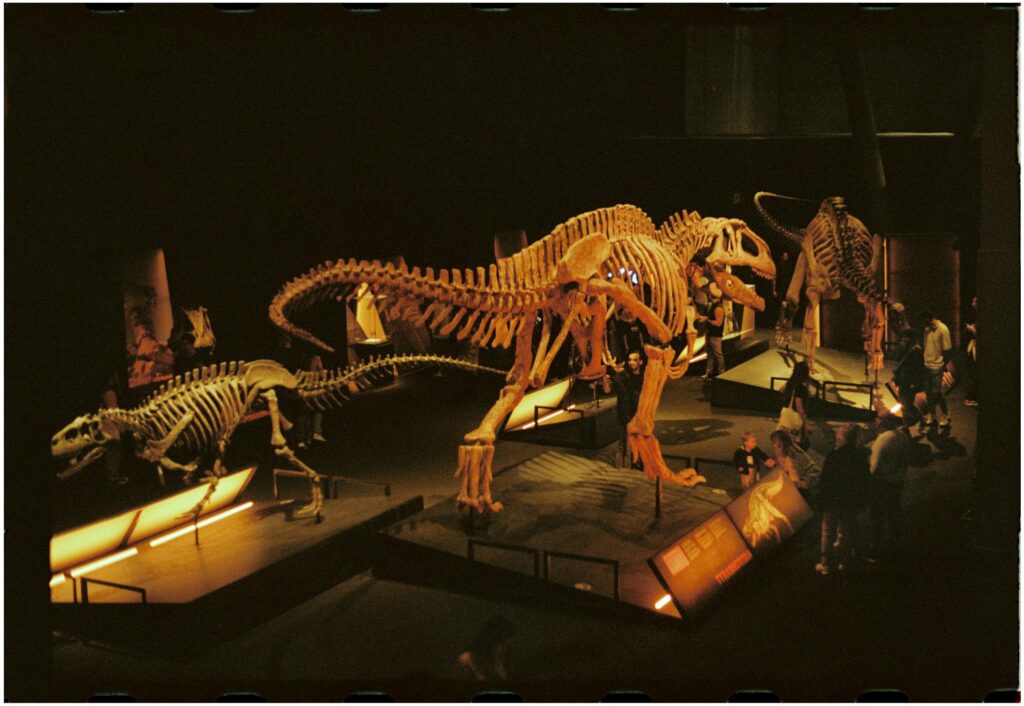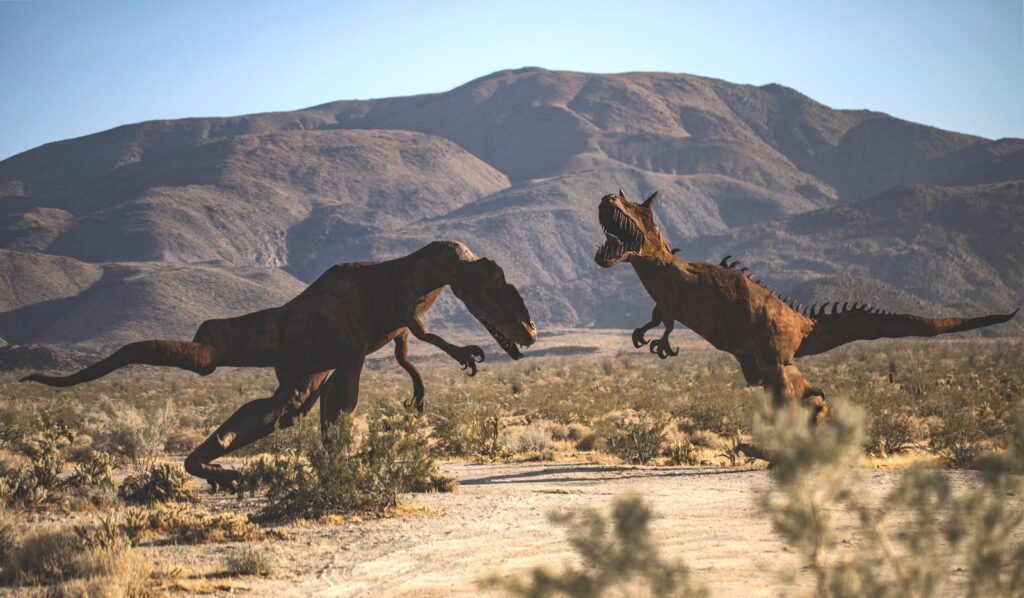The Tyrannosaurus rex has captivated our imagination since its discovery over a century ago, standing tall in museum displays and dominating prehistoric narratives as the quintessential apex predator. With its massive skull, bone-crushing bite force, and fearsome reputation, the T. rex has long been portrayed as the undisputed king of the dinosaur world. But was this iconic theropod truly the ultimate apex predator of its time?
The question involves examining not just its impressive physical attributes but also contextualizing the T. rex within its ecosystem, comparing it to other formidable prehistoric hunters, and considering the latest paleontological evidence. This exploration takes us through 66 million years of evolutionary excellence to determine whether the T. rex deserves its crown as history’s most fearsome carnivore.
The Anatomy of a Super Predator

The tyrannosaurus rex possessed physical adaptations that made it an exceptionally efficient killing machine. Standing up to 12 feet tall at the hip and measuring approximately 40 feet from snout to tail, an adult T. rex dominated its Late Cretaceous landscape through sheer size alone. Its most striking feature was undoubtedly its massive skull, which measured up to 5 feet in length and housed dozens of serrated teeth, some exceeding 12 inches, including the root. These teeth weren’t just large—they were specifically designed to withstand enormous pressure, with reinforced roots and a strength capable of crushing bone.
The biomechanics of the T. rex’s jaw produced a bite force estimated between 7,000-8,000 pounds of force, the strongest of any terrestrial animal ever discovered. Combined with binocular vision that provided excellent depth perception and powerful hind limbs for pursuit, the T. rex’s anatomy presents compelling evidence for its status as an evolutionary masterpiece of predatory design.
The Controversial Hunting Debate

Perhaps no aspect of T. rex biology has sparked more scientific controversy than whether it was primarily a hunter or scavenger. The traditional view of T. rex as an active predator bringing down large prey was challenged in the late 20th century by paleontologists who suggested its massive size and relatively small forelimbs might indicate scavenging behavior.
However, contemporary research strongly supports that the T. rex was indeed an active and capable hunter. Computer models of its locomotion suggest it could reach speeds of 10-25 mph—sufficient to pursue many of the herbivores sharing its habitat. Recent studies of its sensory abilities reveal acute vision and an exceptional sense of smell, both crucial for tracking prey.
Fossil evidence of healed T. rex bite marks on hadrosaurs and ceratopsians further supports the hunting hypothesis. Most paleontologists now believe T. rex likely employed a mixed feeding strategy, hunting when possible and scavenging when opportunities arose, much like modern apex predators such as lions and wolves.
Size Matters: Growth and Sexual Dimorphism

The T. rex’s status as an apex predator was partly defined by its remarkable growth pattern and potential sexual dimorphism. Fossil records indicate that juvenile T. rex specimens were relatively slender and agile, suggesting different hunting strategies than their massive adult counterparts. Growth curve analyses show that the T. rex experienced an extraordinary growth spurt during adolescence, gaining up to 4.6 pounds per day during peak growth years—a rate unparalleled among terrestrial carnivores. This rapid growth transformed a relatively fast, pursuit predator into the massive bone-crusher we recognize in adult specimens.
The question of sexual dimorphism remains contentious among paleontologists, with some research suggesting females may have been larger and more robust than males, potentially indicating different hunting specializations between sexes. If confirmed, this dimorphism would indicate T. rex populations had evolved specialized hunting roles, further supporting their ecological dominance as they could collectively exploit different prey resources through different hunting strategies.
The Cretaceous Arms Race

The T. rex’s development as an apex predator must be understood within the context of the evolutionary arms race occurring during the Late Cretaceous period. As the T. rex evolved more powerful jaws and hunting capabilities, its potential prey—including the Triceratops, Ankylosaurus, and Edmontosaurus—simultaneously developed impressive defensive adaptations.
Triceratops possessed three formidable horns and a protective neck frill that made frontal attacks extremely dangerous even for a T. rex. Ankylosaurus developed heavy body armor and a massive tail club capable of breaking bones on impact. These defensive specializations suggest the intense selective pressure that the T. rex exerted on the ecosystem as the dominant predator.
The co-evolution of predator and prey demonstrates a classic evolutionary arms race, with the T. rex developing greater strength and hunting prowess while herbivores evolved increasingly sophisticated defenses. This pattern of parallel adaptation strongly supports the T. rex’s position as the primary selective force driving herbivore evolution in its ecosystem—a hallmark characteristic of a true apex predator.
T. Rex vs. Spinosaurus: Battle for the Crown

Any discussion of the T. rex’s status as the ultimate apex predator must address its contemporary rival, the Spinosaurus aegyptiacus. Slightly longer than the T. rex and equipped with distinctive neural spines forming a massive sail-like structure, Spinosaurus has challenged the T. rex’s supremacy in popular imagination since its discovery.
Recent research reveals Spinosaurus was primarily a semi-aquatic predator specializing in hunting fish and other aquatic prey, with adaptations including dense bones for buoyancy control and a crocodile-like snout. This ecological specialization places Spinosaurus in a fundamentally different niche than the terrestrial-hunting T. rex. While Spinosaurus may have been the apex predator of riverine and coastal environments, its skull and jaw structure lacked the bone-crushing capabilities that made the T. rex so formidable against large terrestrial prey.
This comparison highlights how the apex predator status must be evaluated within specific ecological contexts rather than through simple size comparisons. In terrestrial Late Cretaceous North American ecosystems, T. rex remained unmatched in predatory capability.
Global Competition: Other Theropod Giants

T. rex’s claim to apex predator status becomes more complex when examined on a global scale across different time periods. Carcharodontosaurids like Giganotosaurus and Carcharodontosaurus rivaled or slightly exceeded the T. rex in length and possibly mass, dominating South American and African ecosystems millions of years before the T. rex evolved. These predators featured different adaptations, with skulls designed more for slicing than crushing, suggesting specialization for different prey types.
The slightly earlier Tyrannosaurid relative Tarbosaurus bataar from Asia closely resembled T. rex in form and function, occupying a similar ecological niche in its habitat. Additional contenders include the massive Mapusaurus, which may have hunted in packs to bring down enormous sauropods, and the nimble Dakotaraptor, whose speed and agility would have made it a formidable predator despite its smaller size.
This global perspective reveals that while the T. rex may have been the ultimate apex predator in its specific time and place, numerous theropods evolved parallel apex adaptations in different ecosystems throughout the Mesozoic Era.
The Intelligence Factor

One often overlooked aspect of the T. rex’s predatory capability was its relatively advanced cognitive abilities. Endocasts of T. rex brains suggest it possessed one of the highest encephalization quotients (brain-to-body-size ratio) among dinosaurs, with brain structure indicating enhanced sensory processing. The expanded cerebrum suggests the T. rex may have had more sophisticated problem-solving abilities than many of its contemporaries.
These cognitive advantages would have translated to superior hunting strategies, including ambush planning, prey selection, and territorial awareness. The enlarged olfactory bulbs indicate exceptional smell detection capabilities, potentially allowing T. rex to track prey over vast distances—a crucial advantage for a top predator.
Recent research suggests T. rex likely possessed intelligence comparable to modern crocodilians and some birds, making it quite cognitively advanced for a non-avian dinosaur. This combination of physical strength and relatively advanced intelligence reinforces T. rex’s position as an exceptionally well-adapted apex predator, capable of outsmarting prey and adapting to changing hunting conditions.
The Social Question: Lone Hunter or Pack Predator?

The question of whether T. rex hunted alone or in cooperative groups represents one of the most significant ongoing debates in paleontology, with major implications for its status as an apex predator. Traditional interpretations portrayed T. rex as a solitary hunter, using its immense size and strength to bring down prey individually.
However, several fossil sites have yielded multiple T. rex specimens in close proximity, raising the possibility of social behavior. The “Trix” site in Montana, for example, contained three T. rex specimens of different ages preserved together, potentially indicating family group structure.
If T. rex did indeed hunt in family groups or packs, its effectiveness as an apex predator would be dramatically enhanced, allowing it to tackle even the largest and most well-defended prey animals in its ecosystem.
The social hunting hypothesis remains controversial, with some scientists suggesting the multiple specimen sites might represent scavenging aggregations rather than social groups. Nevertheless, even the possibility of occasional cooperative hunting would place the T. rex in an even more formidable position atop the Late Cretaceous food chain.
The Ecosystem Impact

A defining characteristic of apex predators is their disproportionate impact on entire ecosystems, and the T. rex shows clear evidence of exerting such influence. As the dominant predator in its habitat, the T. rex would have regulated herbivore populations through direct predation, preventing overgrazing and maintaining plant diversity.
Fossil evidence from the Hell Creek Formation shows diverse herbivore populations existing in equilibrium, suggesting effective top-down control from predators like T. rex. The presence of such a formidable hunter would have created “landscapes of fear,” where herbivores modified their behavior and movement patterns to avoid predation, indirectly affecting vegetation patterns. T. rex also likely influenced the behavior and evolution of smaller predators through competitive exclusion and intraguild predation, as modern apex predators do.
The specific tooth morphology and bite characteristics of the T. rex appear specialized for exploiting large ceratopsians and hadrosaurs, suggesting co-evolutionary relationships where predator and prey evolved in response to each other—a classic signature of an apex species. These ecosystem-wide effects reinforce the T. rex’s position as more than just a large predator but a keystone species shaping its entire food web.
Reign Limited by Geography and Time

While evidence supports the T. rex’s apex status within its ecosystem, it’s important to recognize the limitations of its dominance in both geographic and temporal terms. T. rex fossils have been discovered exclusively in western North America, from Alberta to Texas, indicating its range was restricted to a specific biogeographic province.
During this same period, different apex predators dominated other continents—Tarbosaurus ruled Asia, while abelisaurids like Majungasaurus were apex predators in the southern continents. The T. rex’s evolutionary reign was also remarkably brief in geological terms, lasting approximately 2-3 million years before the Cretaceous-Paleogene extinction event. This relatively short timespan contrasts with other theropod lineages like allosauroids, which maintained apex positions for tens of millions of years across multiple continents.
The geographic and temporal constraints on the T. rex’s dominance highlight how the apex predator status must be considered within specific ecological and evolutionary contexts rather than as an absolute designation. The T. rex was unquestionably the ultimate predator of its time and place, but its reign was limited to a specific evolutionary moment in Earth’s history.
Modern Analytical Approaches

Contemporary paleontological techniques have transformed our understanding of the T. rex’s predatory capabilities through quantitative analysis rather than speculation. Finite element analysis—a computer modeling technique borrowed from engineering—has allowed scientists to simulate stress and strain on T. rex skulls during different biting scenarios, confirming its ability to exert enough force to crush bone while maintaining skull integrity.
Stable isotope analysis of T. rex teeth has revealed carbon and nitrogen signatures indicating a diet consisting primarily of large herbivores rather than carrion, supporting its role as an active predator. Motion studies using digital reconstructions of T. rex musculature suggest it could achieve turning circles and acceleration rates sufficient for effective predation strategies despite its size.
Comparative phylogenetic analyses have tracked the evolution of predatory adaptations across the tyrannosaur family tree, showing that the T. rex represented the culmination of trends toward increased size, bite force, and sensory capability. These sophisticated analytical approaches have largely confirmed what earlier generations of paleontologists suspected—that the T. rex possessed a unique combination of adaptations, making it exceptionally effective at large prey acquisition and processing.
The Legacy of the T. Rex in Modern Apex Predators

The evolutionary legacy of the T. rex can be observed in the apex predators that dominate ecosystems today, offering insights about what truly makes a supreme carnivore. Modern terrestrial apex predators like lions, tigers, and wolves share several key adaptations with the T. rex, including enhanced sensory capabilities, social behavior (in some species), and specialized killing techniques.
However, none approach the sheer killing power of a T. rex’s bite force or its size advantage over prey. The closest analogues to the T. rex in terms of ecological dominance might be killer whales and great white sharks, which combine intelligence, social coordination, and physical strength to dominate their marine ecosystems. The modern saltwater crocodile, with its powerful bite and ambush hunting strategy, perhaps most closely resembles aspects of the T. rex’s predatory approach.
What sets the T. rex apart from modern apex predators is the extreme disparity between its physical capabilities and those of its competitors—while modern ecosystems often feature several competing apex species, the T. rex stood alone at the top of its food chain with no serious rivals. This comparison emphasizes just how exceptional the T. rex was as a predatory adaptation, representing an apex predator archetype that has never been precisely replicated.
The Verdict: Ultimate Apex Predator?

After examining the extensive evidence across multiple domains—anatomy, behavior, ecological impact, and comparative analysis—a compelling case emerges for the T. rex as perhaps the ultimate terrestrial apex predator in Earth’s history. Its combination of massive size, unprecedented bite force, relatively advanced sensory capabilities, and potential social behavior created a predatory profile unmatched by any single terrestrial carnivore before or since.
While other theropods may have exceeded it in specific metrics like length or speed, none combined all the predatory advantages that the T. rex possessed. Its evolutionary timing at the end of the Cretaceous represents the culmination of 165 million years of theropod development, with T. rex embodying the most refined version of the large predatory dinosaur form.
The ecological dominance it exhibited over both herbivores and smaller predators in its ecosystem was complete and unchallenged. If we define “ultimate apex predator” as the most perfectly adapted large-bodied carnivore relative to its ecosystem, the T. rex makes an exceptionally strong claim to the title, standing as nature’s most perfect expression of predatory specialization in terrestrial environments.
Conclusion

The evidence overwhelmingly supports the Tyrannosaurus rex’s status as one of Earth’s most formidable apex predators. Its unparalleled combination of size, strength, sensory capabilities, and possible social behavior created a predatory profile that dominated the Late Cretaceous landscape of North America.
While other magnificent predators ruled different times and ecosystems—from the massive marine pliosaurs to modern killer whales—T. rex represented the pinnacle of terrestrial predatory evolution, a perfect storm of adaptations that made it the unchallenged ruler of its domain.
The ongoing fascination with the T. rex reflects not just our cultural obsession with superlatives but a recognition that in this animal, evolution crafted something truly exceptional—a creature that, 66 million years after its extinction, still defines our understanding of what it means to be the ultimate predator.




